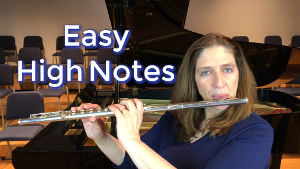One of the hardest things that we flute players have to deal with is our third octave. Our instinct is to close it right up. The embouchure gets smaller and the teeth move closer together because that helps us to control that upper register.
Control is what you want when the ensemble director yells for you to play softly on a 3rd octave B. You as a college student are looking at the director thinking “are you crazy? It’s a high B! I can’t possibly play that softly.” That’s precisely when the embouchure just closes right up. Yes, it helps to play softer and control that sound. But you lose the resonant tone quality. Plus it’s rife with intonation problems.
When I work with a student, that has a very tight embouchure in the upper register, I let them know that they have a very nice tone. Because a small embouchure takes out the air. A tone with little air becomes clear and controlled. The problem is that it has the depth of a half millimeter.
That’s as much as you’ve got.
You don’t have any range. That kind of tone can’t get loud and it doesn’t get much softer either. The tone stays right there.
To work on your high register, you need to do the opposite of your instincts. Open up more than you think you can. Being more open will give you a more resonant tone quality. Because opening up the embouchure allows more partials or harmonics to appear in your tone. Sometimes students don’t believe that you can actually play a note when you are that open. But when they actually try, they believe! You just have to believe that opening up, keeping it more open than you possibly think is the best way to go.
We also want the 3rd octave to have as much of a dynamic range as possible. When you open up, all of a sudden there’s some sound and it’s not tiny. This sound could be played softly but also could be a forte!
I remember when I used to have a tight embouchure. Anytime I had to play any length of time in the 3rd octave, my cheeks got so tight and tired. I felt like I needed a facial massage to loosen my cheeks. By opening up, it loosens the embouchure up. Because you can’t be tight and open at the same time. They don’t go together.
Believe me, it can be fun to play in your third octave. You don’t have to be afraid of it. So try opening up your upper register. Don’t let it be tight. Open your teeth and your lips more open than you possibly think you can.
Have fun working on that. Your upper register, your third octave can be fun and beautiful, without being screechy and harsh.
Have fun!
DoctorFlute
Watch me demonstrate this FluteTips 90 Opening Your High Register


Getting Spin on Your Third Octave Notes – FluteTips 171

Octave Slurs for Better High Notes on the Flute – FluteTips 125

Perfecting Your Third Octave Flute Tips 105

